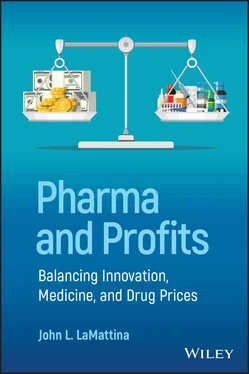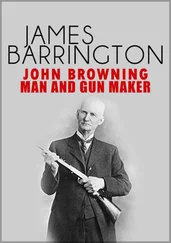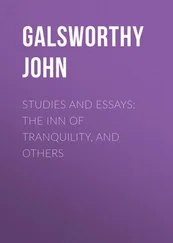John L. LaMattina - Pharma and Profits
Здесь есть возможность читать онлайн «John L. LaMattina - Pharma and Profits» — ознакомительный отрывок электронной книги совершенно бесплатно, а после прочтения отрывка купить полную версию. В некоторых случаях можно слушать аудио, скачать через торрент в формате fb2 и присутствует краткое содержание. Жанр: unrecognised, на английском языке. Описание произведения, (предисловие) а так же отзывы посетителей доступны на портале библиотеки ЛибКат.
- Название:Pharma and Profits
- Автор:
- Жанр:
- Год:неизвестен
- ISBN:нет данных
- Рейтинг книги:4 / 5. Голосов: 1
-
Избранное:Добавить в избранное
- Отзывы:
-
Ваша оценка:
- 80
- 1
- 2
- 3
- 4
- 5
Pharma and Profits: краткое содержание, описание и аннотация
Предлагаем к чтению аннотацию, описание, краткое содержание или предисловие (зависит от того, что написал сам автор книги «Pharma and Profits»). Если вы не нашли необходимую информацию о книге — напишите в комментариях, мы постараемся отыскать её.
Pharma and Profits — читать онлайн ознакомительный отрывок
Ниже представлен текст книги, разбитый по страницам. Система сохранения места последней прочитанной страницы, позволяет с удобством читать онлайн бесплатно книгу «Pharma and Profits», без необходимости каждый раз заново искать на чём Вы остановились. Поставьте закладку, и сможете в любой момент перейти на страницу, на которой закончили чтение.
Интервал:
Закладка:
Interestingly, two professors, Dr. Anne Spaulding (Emory University) and Dr. Jagpreet Chhatwal (Harvard Medical School), have proposed a solution to this problem – “Nominal Pricing [7].”
“This pricing mechanism provides deep discounts of at least 90 percent on drugs to so‐called safety‐net facilities. (By law, the nominal price of a drug must be less than 10 percent of its average market price.) These include hospitals and clinics that treat many patients without insurance or who are homeless. Because of the high markup on hepatitis C drugs, a nominal price is still well above the cost to manufacture the pills.
Nominal pricing permits manufacturers to sell drugs to safety‐net facilities at a low price without disrupting the Medicaid market. Offering a discount to one customer usually triggers a similar discount on any drugs sold in the Medicaid program. Nominal pricing provides a way to prevent this from happening, and so can entice drug manufacturers into offering substantially lower prices to safety‐net facilities that otherwise may not be able to afford certain drugs”
Source: [7]/STAT.
Adoption of such a proposal has obvious benefits. Nominal pricing would bring the cost of treating hepatitis C in prisons to $2500 a patient – much cheaper than treating them after they are released, thus saving the healthcare system a significant sum by avoiding downstream costs. However, putting downstream costs aside, an inmate has a right to medical care. This is the right thing to do.
* * * * * * * * * * * * * *
There was a time when curing a disease like hepatitis C would have generated tremendous praise for the pharmaceutical industry. The innovator company would have been lauded for its creativity, insights, and diligence. Interviews would have been conducted with patients who were relieved and grateful that they would not have to endure the consequences of hepatitis C, quite possibly even death. But, the approval of Gilead’s Sovaldi TMsaw little of that. Instead, everyone focused on “The $1000 Pill.”
To a certain extent, that was not a surprise. The industry was getting battered on multiple fronts and this was another opportunity for critics, politicians, and insurance companies to weigh in and focus not on the benefits of the drug, not on the ultimate savings – even at the $84 000 price – that the healthcare system would gain. Rather, the focus was on the drug’s list price.
Yet, the cost of Sovaldi TMended up dropping dramatically. Competition with new hepatitis C drugs enabled payers to negotiate much lower prices, such that the United States was paying less than other nations for these drugs. This is amazing given that countries like the United Kingdom and Germany as single payer nations have remarkable bargaining power since they are buying for their entire populations. Furthermore, at some point, these prices will drop even more dramatically as the patents that currently protect these drugs will expire. Once generic manufacturers enter the picture, curing hepatitis C will likely cost a few thousand dollars a patient.
There are those who will say that, even at a cost of $25 000 per treatment, these drugs are overpriced and that pharmaceutical companies are gouging the public. Yet, there is no evidence of that. If you look at the industry’s return on investment or return on capital, this industry’s performance is about average across similar sectors. But there is nothing average about the benefits biopharma delivers. As will be seen in subsequent chapters, this is an industry capable of saving the lives of millions of people.
REFERENCES
1 1. Smith, Michael (2014). AHIP Blasts “Unsustainable” Drug Costs. Med Page Today, 21 May.
2 2. Forbes Healthcare Summit (2015). Better, Cheaper, Safer: Creating the Care We Deserve, 2 December.
3 3. Forbes Healthcare Summit (2016). Solving Healthcare’s Biggest Challenges, 30 November.
4 4. 24th Annual Wharton Health Care Conference (2018). Adapting to Consumer‐Driven Care, 23 February.
5 5 LaMattina, J. (2018). The VA Will eliminate hepatitis C in veterans by year‐end. Forbes Media LLC. (1 March 2018).
6 6. Thanthong‐Knight, Siraphob (2018). State Prisons Fail To Offer Cure To 144,000 Inmates With Deadly Hepatitis C. Kaiser Health News. 9 July.
7 7. Spaulding, A.C., Chhatwal, J. (2019). “Nominal Pricing” can help prisons and jails treat hepatitis C without breaking the bank. STAT. 9 January.
CHAPTER 2 ENTER THE PAYERS: FDA APPROVAL DOES NOT GUARANTEE COMMERCIAL SUCCESS
The introductionof the statin class of drugs revolutionized the treatment of heart disease. These drugs, notably Lipitor TMand Crestor TM, lower the levels of low‐density lipoprotein cholesterol (LDL‐c), the “bad cholesterol.” Numerous studies over the years have shown that these pills reduce heart attacks and strokes in vulnerable populations, that is, those with significant risk factors like atherosclerosis, diabetes, smoking, and a family history of heart disease. In fact, the availability of statins changed medical practice so that physicians now recommend LDL‐c levels less than 100 mg/dl [1].
While statins are impressive drugs, a new class of drugs known as PCSK9 inhibitors emerged, which proved to be even more exciting. These are not pills but biological drugs (antibodies) that must be given by injection. They are designed to block an enzyme that mechanistically limits the effectiveness of statins. When PCSK9 antibodies are combined with statins, the LDL‐c lowering effects are stunning, with levels as low as 30 mg/dl observed. No other therapy can approach such results. Given the consensus that the lower your LDL‐c, the less likely you are to suffer a heart attack or stroke, these results offered great hope to heart patients.
Two PCSK9 antibodies garnered US Food and Drug Administration (FDA) approvals almost simultaneously: Praluent TM(from Regeneron/Sanofi) on 24 July 2015 and Repatha TM(from Amgen) on 27 August 2015. The launches of these drugs should have been celebrated by the cardiovascular medical community. Instead, any enthusiasm was tempered when the prices of these drugs were announced: $14 600 per patient per year for Praluent TMand $14 000 per patient per year for Repatha TM. It should be noted that these are list prices. Furthermore, these are not pills but injectable biologics that are expensive to manufacture, store, and distribute. Thus, these prices were expected to be higher than oral statins – but not that much higher.
The ensuing outcry was to be expected. Dr. Steve Miller of Express Scripts, echoing his previous views on hepatitis C drugs, said that “Even if physicians adopt this new therapy slower than anticipated, it is clear that PCSK9 inhibitors are on a path to become the costliest therapy class that this country has even seen”[2]. In reality, this did not happen. In fact, 2020 sales of these drugs were quite modest with sales of $887 million for Repatha TMand $358.8 for Praluent TM. How could such expensive breakthrough drugs generate such disappointing sales?
Just because a drug has been approved by the FDA does not mean that insurance companies will pay for it. First, there were two PCSK9 inhibitors available, so payers encouraged Amgen and Regeneron/Sanofi to bid against each other for positions on their formularies. Remember, the roughly $14 000 price tag was the list price. Details for the deals that companies strike with payers are confidential. Given the choice between Regeneron’s Praluent TMand Amgen’s Repatha TM, Express Scripts opted for the former. While he did not say what Express Scripts was actually paying for Praluent TM, Dr. Len Schleifer, chief executive officer (CEO) of Regeneron, glumly told a Forbes Healthcare Summit audience, “Dr. Miller drives a hard bargain.” Clearly, Express Scripts as well as other payers were shelling out far less than $14 000 for these medicines.
Читать дальшеИнтервал:
Закладка:
Похожие книги на «Pharma and Profits»
Представляем Вашему вниманию похожие книги на «Pharma and Profits» списком для выбора. Мы отобрали схожую по названию и смыслу литературу в надежде предоставить читателям больше вариантов отыскать новые, интересные, ещё непрочитанные произведения.
Обсуждение, отзывы о книге «Pharma and Profits» и просто собственные мнения читателей. Оставьте ваши комментарии, напишите, что Вы думаете о произведении, его смысле или главных героях. Укажите что конкретно понравилось, а что нет, и почему Вы так считаете.












